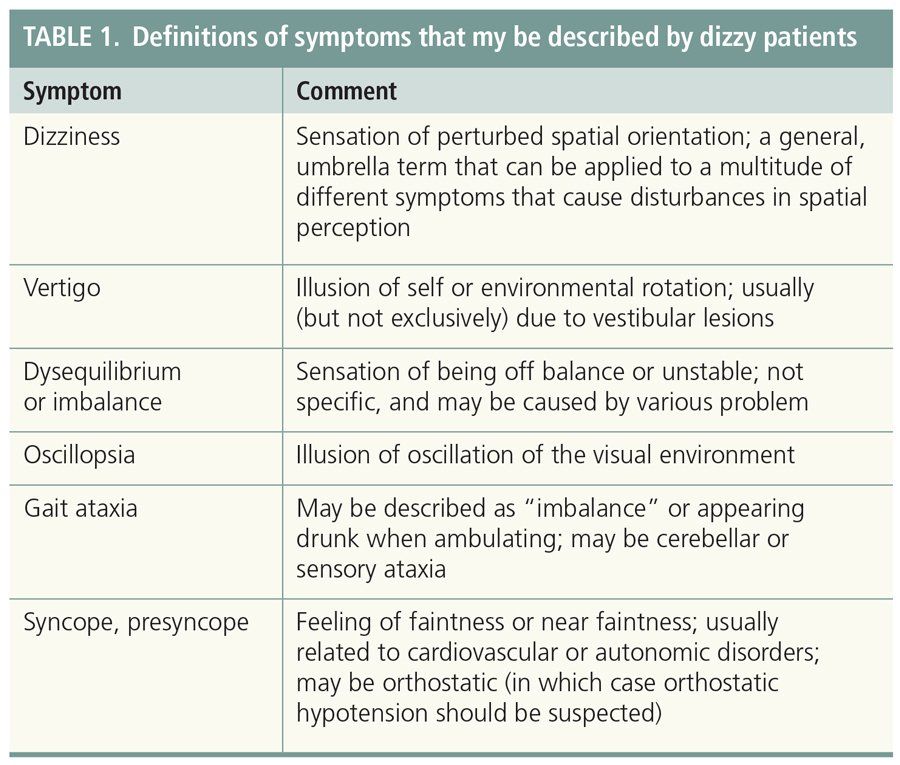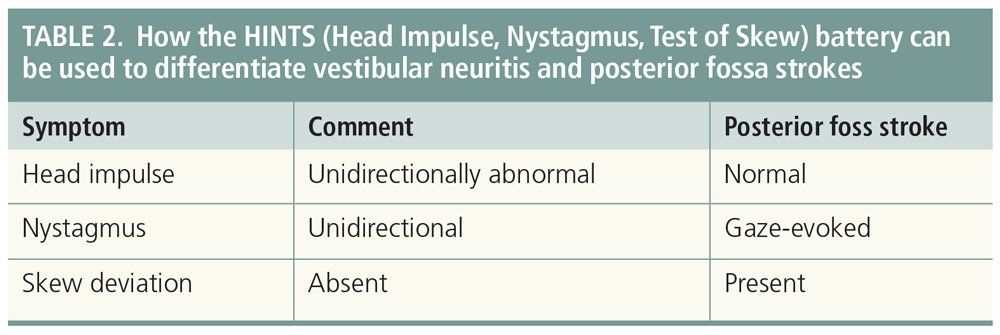News
Article
Top 5 CNS Causes of Dizziness
Author(s):
An emphasis on importance of taking a detailed history and careful neurologic examination focused on the vestibular system.
Table 1. Definitions of symptoms that may be described by dizzy patients

Table 2. How the HINTS battery can be used to differentiate vestibular neuritis and posterior fossa strokes

Dizziness is a general, umbrella term that encompasses a variety of symptoms that impair spatial perception (Table 1). It is the second most common complaint in the ambulatory setting, and constitutes 25% of neurology outpatient referrals and 13% of emergency department (ED) neurology consultations.1-6 While peripheral causes of dizziness (eg, benign paroxysmal positional vertigo, vestibular neuritis) are more common than those arising from the CNS, neurologists are frequently called on to assess patients who complain of dizziness. As such, it is imperative for neurologists to be aware of common CNS causes of dizziness.
Vestibular migraine (VM)
Approximately 10% of adults presenting to specialized dizziness clinics have vestibular migraine7,8; approximately 35% of the patients in my neuro-otologic practice have vestibular migraine.
Many names have been used to describe this entity including vertiginous migraine, migrainous vertigo, migraine-associated dizziness, and migraine-associated vertigo. The term vestibular migraine is preferable since patients may experience a wide range of vestibular symptoms, and not just vertigo. Spontaneous episodes of vestibular symptoms lasting anywhere from seconds to weeks (but most commonly the duration is minutes to 72 hours) are often accompanied by migrainous features (photophobia, phonophobia, typical migraine headache, and/or visual aura). Some patients have positional vertigo; unlike benign paroxysmal positional vertigo, vestibular migraine-related positional vertigo often persists as long as the offending position is maintained, and is not fatigable. In 2012, diagnostic criteria for vestibular migraine were published to help with the diagnosis of vestibular migraine.9 Essentially, the diagnosis is made if patients experience at least 5 episodes of vestibular symptoms of at least moderate intensity (ie, enough to impair daily activities), each lasting between 5 minutes to 72 hours, with most episodes associated with migrainous manifestations (photophobia, phonophobia, headache, or visual aura).
It is important to exclude other causes of dizziness when evaluating a patient with suspected vestibular migraine. Diagnostic confusion with Meniere disease is common, particularly if episodes of vestibular migraine are accompanied by tinnitus, muffled hearing, or ear pressure. The presence of low frequency hearing loss favors the diagnosis of Meniere disease. An aura of brainstem symptoms (eg, diplopia, dysarthria) combined with vestibular complaints is suggestive of basilar migraine.
Multiple sclerosis plaques that affect central vestibular structures may cause recurrent episodes of vestibular symptoms, particularly during illness and with heat exposure (Uhthoff phenomenon). These attacks are not associated with migrainous or aural symptoms, and the demyelinated plaques may be visible on MRI.
Posterior fossa stroke
The term acute vestibular syndrome refers to an acute, monophasic episode of dizziness (typically vertigo or significant disequilibrium) accompanied by nausea, vomiting, gait instability, nystagmus, and head motion intolerance typically lasting for at least 24 hours. If acute vestibular syndrome is accompanied by other centrally localizing signs (eg, hemiparesis, ocular motor palsies), the diagnosis of a posterior fossa stroke is obvious. Isolated acute vestibular syndrome, however, presents a more challenging problem; the clinician must decide if a peripheral or a central vestibular lesion is to blame. While peripheral causes (eg, vestibular neuronitis) are more common, central causes are not infrequent, and are potentially lethal if missed (especially if caused by vertebrobasilar ischemia). Of almost 800,000 strokes annually in the US, 18% are located in the posterior fossa, and up to 70% present with dizziness.10
Since ED providers are generally unable to reliably evaluate patients with dizziness, the responsibility for correctly diagnosing and treating patients with acute vestibular syndrome is often delegated to the neurologist on-call. It is therefore important for neurologists to distinguish peripheral causes (which can be discharged home) from central ones (which demand a more thorough inpatient evaluation).
The HINTS (Head Impulse, Nystagmus, Test of Skew) battery is a three-step bedside examination composed of the head-impulse test (which assesses the integrity of the vestibulo-ocular reflex pathway), assessment of nystagmus, and the alternate cover-test to look for a skew deviation. It has been proven to be more sensitive and specific for detecting posterior fossa strokes compared with early diffusion-weighted MRI.11-13 Specifically, a dangerous HINTS exam has been proven to be a powerful predictor of posterior fossa strokes; a benign HINTS exam typically points to a peripheral vestibular etiology (Table 2).
However, it is important to emphasize that anterior inferior cerebellar arterial strokes can cause a unilaterally abnormal head-impulse test, mimicking the appearance of a peripheral vestibulopathy, because the labyrinthine artery is an anterior inferior cerebellar arterial branch. Because the cochlea and cerebellum are also compromised in anterior inferior cerebellar arterial strokes, central vestibular signs (ie, gaze-evoked nystagmus and skew deviation) and acute unilateral sensorineural hearing loss would be present as well.
Chiari malformation type 1
Type I Chiari malformation is the most common of the Chiari malformations; it is defined as descent of the cerebellar tonsils at least 5 mm past the foramen magnum. Symptoms typically appear insidiously in the second or third decade of life. Patients commonly describe occipital and neck pain provoked by physical activity or maneuvers that increase intracranial pressure.
Audiovestibular symptoms are also common in this condition. These include imbalance, vertigo, nystagmus (horizontal and downbeat are the most common), hearing loss, and tinnitus. Aural fullness and even drop attacks have also been observed, creating diagnostic confusion with Meniere disease. Patients may have lower cranial neuropathies (affecting CN IX, X, XII) and upper extremity involvement (radicular pain and/or paresthesiae due to coexisting syringomyelia).
Symptomatic Chiari malformations should be referred for neurosurgical evaluation and consideration for posterior fossa decompression. However, it is important to note that Chiari type I malformations may be asymptomatic and discovered incidentally when the patient undergoes MRI for dizziness arising from a different etiology. A careful history is imperative to determine if the Chiari malformation is truly symptomatic, or if another etiology may be responsible for the patient’s dizziness. The lack of headache, neck pain, or vestibular symptoms provoked by coughing, or Valsalva maneuver argues against a symptomatic Chiari type I malformation. Such patients should not be subjected to the risks of surgery.
Post-concussion syndrome
In the US, 44 million children and 170 million adults participate in sports, and there are approximately 3.8 million sports-related concussions annually.14,15 Concussions are the mildest form of traumatic brain injury; it is a transient functional disorder caused by direct trauma, rapid acceleration-deceleration of the head, or blast forces. Post-concussion syndrome has been reported to occur in 30% to 80% of concussed individuals; this wide variation may reflect different reporting standards, as well as comorbid psychiatric and medicolegal issues. While it typically resolves within 3 months, post-concussion syndrome may persist in about 20% of concussed individuals.
Headache and dizziness are very common symptoms. Other symptoms include light and sound sensitivity, nausea, tinnitus, cognitive dysfunction (mental fog), problems with visual focus, sleep changes, depression, anxiety, and irritability. Dizziness may be due to direct CNS effects of the trauma (causing axonal injury and other microstructural damage), vestibular migraine, and neuropsychiatric disorders (eg, anxiety, depression, PTSD).16 Post-traumatic benign paroxysmal positional vertigo is not uncommon in concussion, but other post-traumatic injuries to the peripheral vestibular apparatus (eg, perilymphatic fistula, otolithic injury, labyrinthine concussion) are rarely encountered. A detailed history and examination are crucial when assessing dizziness because the treatment needs to address the underlying etiology.
Neurodegenerative disorders
Dizziness may be a manifestation of many neurodegenerative disorders. At presentation, Parkinson disease patients may describe the shuffling or festinating gait as being “dizzy” or “off balance.” Medications such as levodopa or dopamine agonists (eg, pramipexole, ropinorole) may cause orthostatic hypotension, and hence presyncopal dizziness.
The Parkinson-plus disorders often cause many symptoms that are construed as “dizziness.” Multiple system atrophy causes dysautonomia (causing orthostatic presyncope or syncope), vertigo, nystagmus (causing oscillopsia), and/or cerebellar findings (leading to gait ataxia). Progressive supranuclear palsy often presents with falls and complaints of imbalance; loss of downgaze often causes imbalance when descending stairs.
Spinocerebellar ataxias are a group of inherited degenerative disorders characterized by insidious, progressive cerebellar ataxias sometimes accompanied by other neurologic deficits depending on the type. Early in the disease, patients with spinocerebellar ataxias may see neurologists for evaluation of ataxia or oscillopsia.
Conclusion
Dizziness that arises from CNS causes is not infrequently encountered in neurologic practice. The most common CNS cause of dizziness is vestibular migraine, while posterior fossa strokes constitute the most urgent etiology of acute vestibular syndrome that carries potentially significant morbidity and even mortality. A detailed history and careful neurologic examination focused on the vestibular system almost always reveal clues about the underlying cause of dizziness.
Disclosures:
Dr Beh is Assistant Professor of Neurology, Director, Vestibular & Neuro-Visual Disorders Clinic, University of Texas Southwestern Medical Center at Dallas.
References:
1. Moulin T, Sablot D, Vidry E, et al. Impact of emergency room neurologists on patient management and outcome. Eur Neurol. 2003;50:207-214.
2. Newman-Toker DE, Kattah JC, Alvernia JE, Wang DZ. Normal head impulse test differentiates acute cerebellar strokes from vestibular neuritis. Neurology. 2008;79:458-460.
3. de Falco FA, Sterzi R, Toso V, et al. The neurologist in the emergency department. An Italian nationwide epidemiological survey. Neurol Sci. 2008;29:67-75.
4. Kerber KA. Vertigo and dizziness in the emergency department. Emerg Med Clin North Am. 2009;27:39-50.
5. Royl G, Ploner CJ, Leithner C. Dizziness in the emergency room: diagnoses and misdiagnoses. Eur Neurol. 2011;66:256-263
6. Vanni S, et al. Can emergency physicians accurately and reliably assess acute vertigo in the emergency department? Emerg Med Australas. 2015;27:126-131.
7. Neuhauser HK, Leopold M, von Brevern M, et al. The interrelations of migraine, vertigo and migrainous vertigo. Neurology. 2001;56:436-441.
8. Dieterich M, Brandt T. Episodic vertigo related to migraine (90 cases): vestibular migraine? J Neurol. 1999;246:883-892.
9. Lempert T, Olesson J, Furman J, et al. Vestibular migraine: diagnostic criteria. J Vestib Res. 2012;22:167-172.
10. Tarnutzer AA, Berkowitz AL, Robinson KA, et al. Does my dizzy patient have a stroke? A systematic review of bedside diagnosis in acute vestibular syndrome. CMAJ. 2011;183:e571-592.
11. Kattah JC, Talkad AV, Wang DZ, et al. HINTS to diagnose stroke in the acute vestibular syndrome: three-step bedside oculomotor examination more sensitive than early MRI diffusion-weighted imaging. Stroke. 2009;40:3504-3510.
12. Newman-Toker DE, Kerber KA, Hsieh YH, et al. HINTS outperforms ABCD2 to screen for stroke in acute continuous vertigo and dizziness. Acad Emerg Med. 2013;20:986-996.
13. Tehrani AS, Kattah JC, Mantokoudis G, et al. Small strokes causing severe vertigo: frequency of false-negative MRIs and nonlacunar mechanisms. Neurology. 2014;83:169-173.
14. Mullally WJ. Concussion. Am J Med. 2017;130:885-892.
15. Bramley H, Hong J, Zacko C, et al. Mild traumatic brain injury and post-concussion syndrome: treatment and related sequela for persistent symptomatic disease. Sports Meds Arthrosc. 2016;24:123-129.
16. Fife TD, Kalra D. Persistent vertigo and dizziness after mild traumatic brain injury. Ann Acad NY Sci. 2015;1343:97-105.





